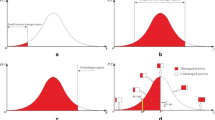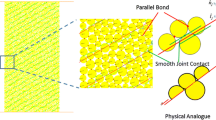Abstract
The paper is devoted to proposing a constitutive model based on micromechanics. The joints in rock masses are treated as penny-shaped inclusion in solid but not through structural planes by considering joint density, closure effect, joint geometry. The mechanical behavior of the joints is represented by an elasto-plastic constitutive law. Mori-Tanaka method is used to derive the relationship between the joint deformations and macroscopic strains. The incremental stress-strain relationship of rock masses is formulated by taking the volume average of the representative volume element. Meanwhile, the behavior of joints is obtained. By using implicit integration algorithms, the consistent tangent moduli are proposed and the method of updating stresses and joint displacements is presented. Some examples are calculated by ABAQUS user defined material subroutine based on this model.
Similar content being viewed by others
Abbreviations
- τ i :
-
stresses of the joint under local coordinates
- g i :
-
relative displacement of joint under local coordinates
- V m :
-
maximum closure of joint
- K n0 :
-
initial normal stiffness
- α 0 :
-
joint asperity surface angle
- µ:
-
friction coefficient
- λ :
-
plastic coefficient
- K e ij :
-
joint elastic stiffness matrix under local coordinates
- C R ijkl :
-
elastic stiffness tensor
- T ij :
-
transformation matrix between joint local coordinates and global coordinates
- ρ J :
-
quantity of one set of joints in per volume
- [u J i ]:
-
relative displacements under global coordinate system
- n i :
-
components of normal direction of joint
- S J :
-
area of joint
- a J :
-
radius of joint
References
Krajcinovic D. Constitutive equations for damaging Materials. J Appl Mech, 1983, 50: 355–360
Budiansky B, O’Connell R J. Elastic moduli of a cracked solid. Int J Solids Struct, 1976, 12(1): 81–97
Hu K X. Estimation of the elastic properties of fractured rock masses. Int J Rock Mech Min Sci Geomech Abs, 1993, 30(4): 381–394
Yoshida H, Horii H. Micromechanics-based continuum model for jointed rock mass and excavation analyses of a large-scale cavern. Int J Rock Mech Min Sci Geomech Abs, 2004, 41(6): 119–145
Plesha M E. Constitutive models for rock discontinuities with dilatancy and surface degradation. Int J Numer Anal Meth Geomech, 1987, 11(5): 345–363
Jing L. A two-dimensional constitutive model of rock joints with pre- and post-peak behavior. Proc Int Conf on Rock Joints, Loen, Norway, 1990, 633–610
Barton N, Bandis S, Bakhtar K. Strength, deformation and conductivity coupling of rock joints. Int J Rock Mech Min Sci Geomech Abs, 1985, 22(4): 121–140
Author information
Authors and Affiliations
Corresponding author
Rights and permissions
About this article
Cite this article
Zhu, F., Dui, G. & Ren, Q. A continuum model of jointed rock masses based on micromechanics and its integration algorithm. Sci. China Technol. Sci. 54, 581–590 (2011). https://doi.org/10.1007/s11431-011-4289-0
Received:
Accepted:
Published:
Issue Date:
DOI: https://doi.org/10.1007/s11431-011-4289-0




